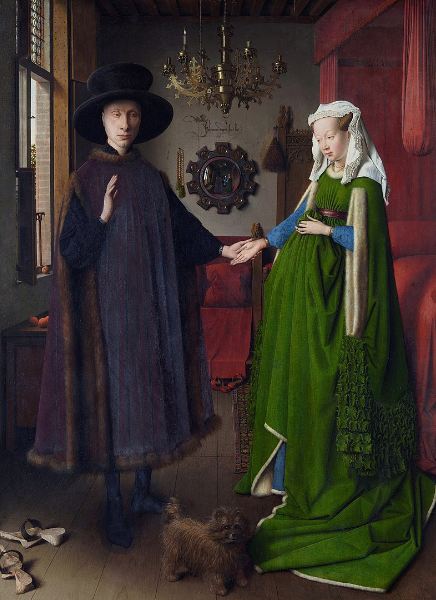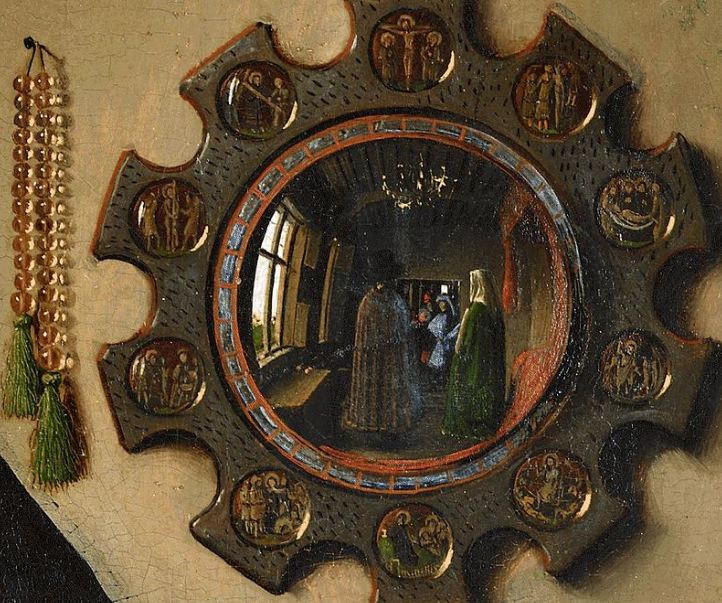The Arnolfini Portrait is the most popular name given to an oil painting created by Jan van Eyck in 1434. The painting, which has the size of a full-length double portrait, is believed to depict an Italian merchant named Giovanni di Nicolao Arnolfini and his wife, Jeanne Cenami, holding hands in one of the rooms of their home located in Bruges, Belgium. The painting is speculated to be a unique form of a marriage contract for Giovanni Arnolfini and his wife.
Considered to be one of the most complex paintings produced in the 15th century, van Eyck applied many of the techniques that he learned in his career as a painting, including geometric orthogonal perspective, and the ability to expand the view of the artwork by painting a mirror to see what is behind and in front of the models. Today, the famous painting is still almost impossible to replicate, due to the fact that van Eyck intricate layers of glazes, colors, and details in the artwork. To know about how the painting came to be, here are the interesting origins of the Arnolfini Portrait.
Origins
The Arnolfini Portrait is believed to have been painted in 1434 when Giovanni Arnolfini and Jeanne Cename were newlyweds. It is currently unknown if the couple had a legitimate marriage contract prior to commissioning the painting, but it is speculated that the Arnolfini Portrait serves as another way to legitimize their marriage.
For many years, historians and art experts assumed that the models in the portrait were Giovanni Arnolfini and his wife, but in a historical record discovered in 1997, it showed that Arnolfini did not marry Cenami until 1447, which is 13 years after van Eyck’s painting was created. With this discovery, the identity of the woman remains a mystery. Some suggest that the man in the painting was not Giovanni Arnolfini, but his cousin, Giovanni di Arrigo, who married someone around the same time as the creation of the portrait. Several experts also speculate that the male model is Arnolfini, and the woman that he is with is either Arrigo’s wife or a hired model. The possibility of the woman being a hired model could be plausible, as the painting could have been created in honor of Arnolfini’s first wife, CostanzaTrenta, who died in February 1433, possibly due to childbirth. Following that logic, it could be said that the hired model is supposed to pose as Costanza for the painting.
Interpretations
There have been many interpretations of the Arnolfini Portrait that arose over the years. It is believed by many that the pose of the two models is supposed to represent gender roles and the perception of marriage during the 15th century. The woman is seen standing near the bed of the room, and her position is supposed to symbolize the role of women in the house, which is to serve as the caretaker who will be responsible for all the housework in her and her husband’s home. On the other hand, the man is seen standing near the window, which suggests that men are the providers that will always go outside their home to work.
The hands that connect the two models together also symbolizes their roles, with the male being more dominated and commanding, while the female is more gentle and allows the man to take care of her and family. However, the gaze of the woman’s eye, which is looking directly at the man’s face, suggests that she is not subservient or submissive.
There is also a more simple interpretation as to why the models are holding hands, and this interpretation implicates that the gesture was just to further strengthen the “evidence of marriage” in the painting.
To most art experts, the most peculiar object in the painting has to be the mirror located at the center and between the two models. Surrounding the larger mirror are smaller mirrors that depict several scenes from the “Passion of Christ,” which was the final period of Jesus Christ’s life. Because of the placement of the scenes from Jesus’s final moments, experts believed that the larger mirror is supposed to represent the eye of God, who is observing the marriage between Arnolfini and his wife. Furthermore, some speculate that the view within the mirror is supposed to represent the two stages of Jesus Christ’s life; the side of Arnolfini is supposed to symbolize the time when Jesus was still alive, and the side of the wife is representing Jesus’s death and resurrection.
Besides the two models, the mirror also reflects the image of two other figures inside the room. One figure is supposed to be van Eyck, while the other is currently unknown. During a private marriage, it is required for the couple two have two witnesses, and in order to legitimize the unique marriage contract, van Eyck painted two more figures (including himself) and signed the painting with his name as proof that he was one of the witnesses.


